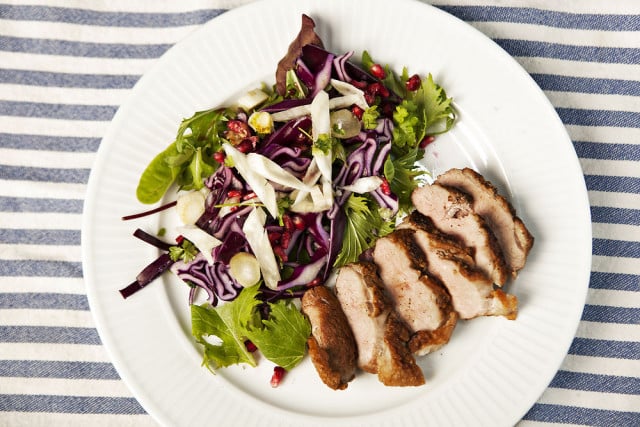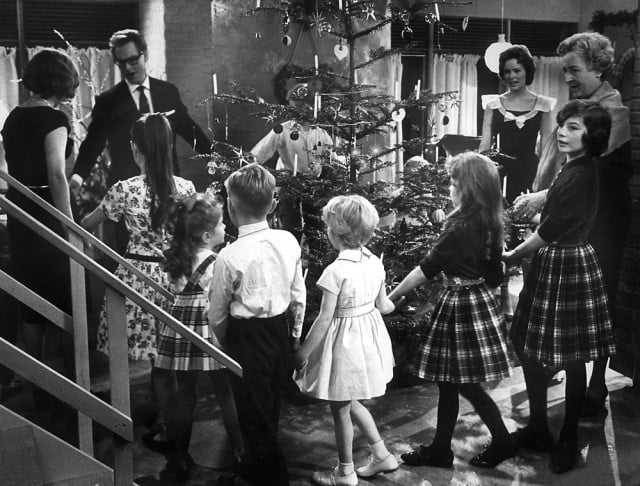The Disney Christmas Show
Christmas always seemed to begin at 4pm on Christmas Eve as the Disney Christmas show flickered on to our TV screen. Everyone in the house put on smart clothes and sat on the sofa with a cup of warm gløgg [traditional Nordic mulled wine, ed.] or hot chocolate.
From All of Us to All of You is known more simply in Danish as Disney juleshow and was first broadcast in Denmark in 1967. The cartoon has become a regular Christmas tradition for many Danes, and for me it remains the sound of Christmas.
Christmas Eve dinner and the excitement about present-opening time
Roast duck, brown potatoes, boiled potatoes, gravy, red cabbage and the ‘Christmas salad’ we invented in my family were the taste of Christmas Eve at my childhood home. The dishes were all arranged in our best china and placed on the Christmas table with its candles and decorations.
READ ALSO: Why do Danes eat duck and pork at Christmas?
It looked and tasted great and very seasonal, but for us kids, it was hard to stay calm and enjoy the food, because we knew what the evening would bring – or at least what we all hoped it would. Gifts are given on the evening of Christmas Eve in Denmark – that can make the day feel long when you’re small.

File photo: Jonas Skovbjerg Fogh/Ritzau Scanpix
Risalamande
Risalamande, a cold rice pudding mixed with whipped cream, vanilla and chopped almonds served with a cherry sauce, is thought to be eaten at nine out of ten Danish Christmas dinners.
It was always brought to our table in an orange bowl which only ever came out at Christmas: a family heirloom from my grandmother. I remember how the lights from the candles glinted against the colour of the bowl.
Before the adults put anything on their plates, my brothers and I were given ours and began chewing. Our mom had to tell us not to chew too hard or we wouldn’t find the one unchopped almond in the dessert (the one who finds the almond wins a little present). Strangely enough, I found a whole almond in my portion every year – and so did my brothers.
Meanwhile, the adults always ate so much risalamande that they ended up needing to lay down on the sofa.
Dancing around the Christmas tree
Our Christmas tree was decorated by my grandmother, with snowballs in natural designs and pretty angels. The adults took my hands and I remember having to stretch to keep hold – I felt like I was permanently making the ‘Y’ in ‘YMCA’. I can clearly remember the rough feel of my carpenter grandfather’s hand and the whole family going around and around as we faced the Christmas tree.
Suddenly we’d go one way, then the other, then back the other way. My dad always said he was getting dizzy and everyone else laughed.

Danes dancing around the Christmas tree, around 1960. File photo: Åge Sørensen/Ritzau Scanpix
A visit from Father Christmas
Santa always came to our house early on Christmas Eve – and always when my dad had to use the bathroom. There was the loud noise of a knock at the window, then at the next window and the next one. Santa was running around the house! I remember trying to run after the noise and being scared at the same time.
Suddenly a tall man in a red Christmas outfit would be standing in the doorway. He’d walk in and loudly pronounce, “Ho ho ho”! Our guest would be carrying a large bag, speak in a mumbling voice and give the children presents from his sack. One year my brother tugged at the beard, which made me feel very awkward. But Santa didn’t seem to mind.
“There are many children and I must go,” he’d say and head out into the dark. Shortly after, Dad would reappear in the kitchen, checking how the Christmas dinner was coming along.
READ ALSO: How to navigate Danish holiday traffic over the Christmas break



 Please whitelist us to continue reading.
Please whitelist us to continue reading.
Member comments